Handoff and Continuity in OS X Yosemite.
For an index of all my Mac Pro articles, click here.
You can read here about these two new OS X technologies coming to Macs with OS X Yosemite, which will be released by Apple on October 16, 2014.
However, because these features use Bluetooth 4.0 they will not work with a stock 2008/2009/2010/2012 classic Mac Pro which does not run this latest version of Bluetooth.
The advantages of these OS X enhancements are described in the linked article; one of the greatest appeals is the ability to take and make phone calls on the Mac Pro as long as your iPhone is nearby within Bluetooth range, as long as you have speakers and a microphone conmected to the Mac Pro.
Thankfully, an entrepreneurial vendor has developed an elegant kit which not only updates the classic Mac Pro to Bluetooth 4.0, it also upgrades wi-fi from 802.11n (or the even older 802.11g) to the latest 802.11ac broadcast by Apple’s current Airport Extreme and Express wifi routers. You can buy the kit here. Availability is spotty, so keep trying – they are providing current iMac integrated cards in this kit. The kit is not cheap at $150+ but better than alternative clunky solutions which require you to run a cable to a USB socket. The latter approach requires a pass through opening somewhere in the Mac Pro’s case unless aftermarket PCIe cards in your chassis include an internal USB socket.
The Apple part (probably p/n 661-7514) retails at $90 so the modifications made by this vendor to permit use in the classic Mac Pro are, in fact, reasonably priced. The existing Airport card is replaced with a new dual Airport/Bluetooth card, with the old Bluetooth card removed and its electrical connector used to connect to the cable from the new Airport card. Further, an additional antenna extension is run from the new Airport card to the old Bluetooth antenna in the Mac Pro’s chassis.
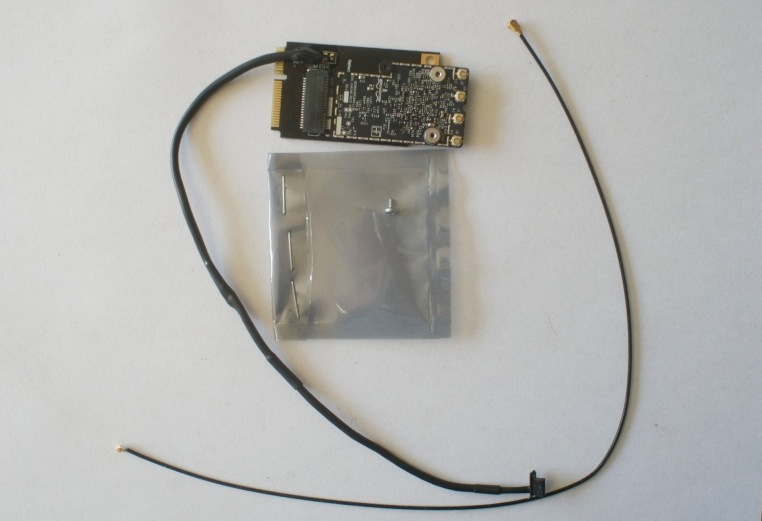
The upgrade kit showing the integrated Airport/Bluetooth card, Bluetooth connector wire, and Bluetooth antenna extension (the thin one). The retaining screw is redundant – reuse one of the two used with your old Airport card.
Full instructions appear on the vendor’s web site but be warned. There are no fewer than five of the minuscule and fragile antenna connectors to insert and while I have installed many Airport cards it’s still touch and go with these. Sometimes it’s easy, sometimes they can be a real pig. The best approach is to secure the new card with one screw (the old card took two), carefully align the connector and push it down into place with a chopstick, or similar.
Note that the new card uses all three of the stock antennae in the Mac Pro; the older Airport card only uses two (the third has its connector shrouded in a clear plastic sleeve and is usually tucked under the stock Airport card) and you may have to fish for the third, which is usually disclosed once the old card is removed. Use a magentized screwdriver for the small retaining screws or be prepared to find the ones you have just lost in the chassis.
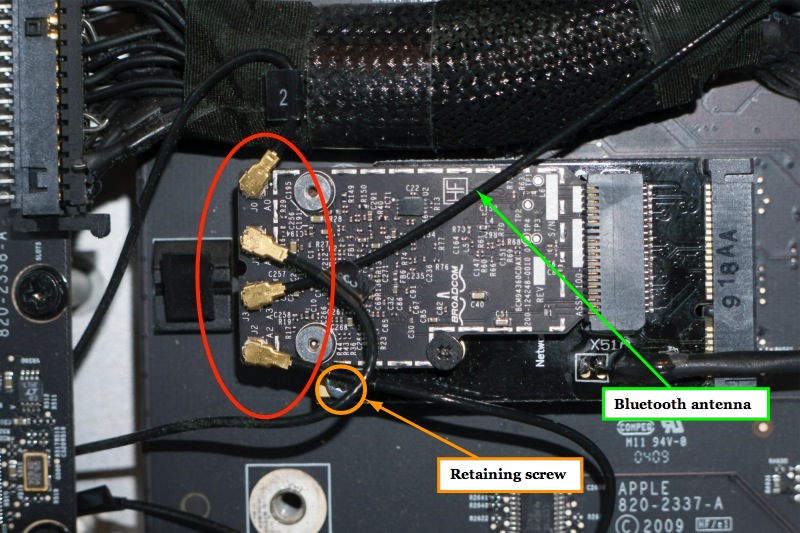
Connectors from hell attached to the new iMac Airport/BT card – red oval.
Three existing and one new BT extension antenna, the latter with one connector at each end.
The process of attaching these small connectors is tricky, and frustration or force are guarantees of failure. If you are ham handed, impatient or sausage fingered, you really have no chance of getting it done right. Even your local Apple Store or Apple technician will struggle. These are simply awfully designed connectors and standard in the industry – it’s not an Apple thing. I actually prefer to pull the processor cage in 2009/2010/2012 Mac Pros but that process requires five Allen bolts, six Philips screws and three tough to disconnect electrical connectors to be removed, as well as requiring both cage fans loosened and moved inwards within the cage and the PCIe fan removed. Not, in other words, a cakewalk, but it does make working with the very short cables on the native antenna cables easier to manipulate into position once the card is retained in place with a single Philips screw. It’s far easier to attach the antenna cables once the Airport/BT card is secured in place. Processor cage removal instructions are linked here.
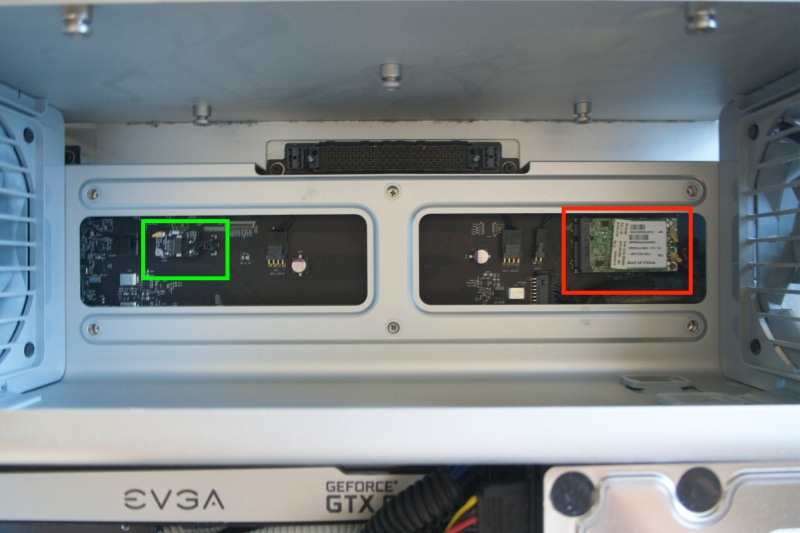
The old BT card (green) and Airport card (red), disclosed when the processor tray is removed.
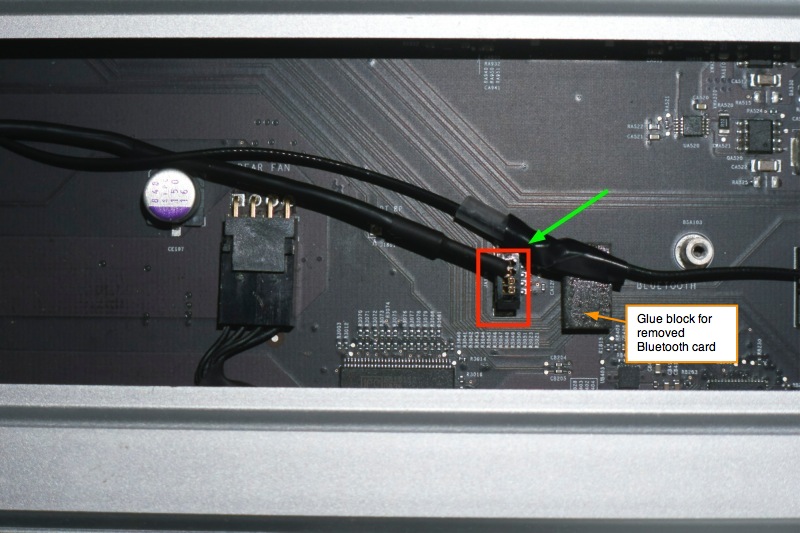
BT data cable (red – also very tricky to insert and keyed, so get it right) and antenna extension (green) attached to the new Airport/BT integrated card.
Most current Apple devices offer 802.11ac, including iPhone 6/6+, and all the latest computers and tablets do so except for the Mac Mini.
You can check the installation in the following screen images from ‘About This Mac’:
Bluetooth 4.0LE:
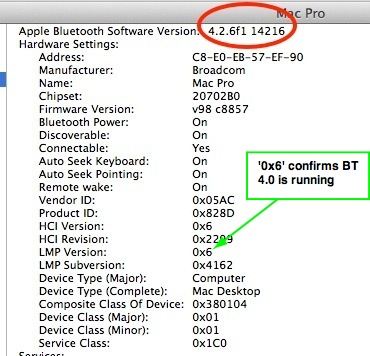
802.11ac wifi:
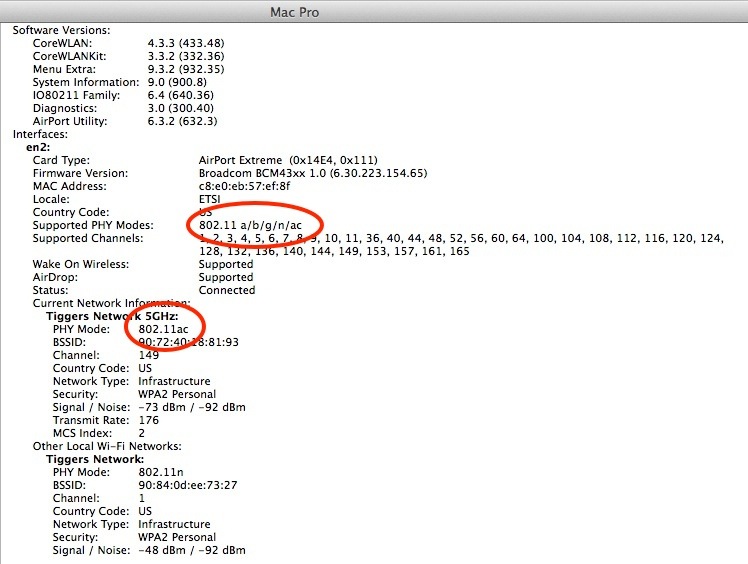
After installation I performed SMC and PRAM resets, consonant with best practice.
Speed? Much as with my MacBook Air, wifi speed is some 20-30% faster in my environment using 802.11ac compared with 802.11n and the Mac Pro’s wifi speed is actually slightly faster than that of my 2014 MacBook Air; forget Apple’s disingenous claims of huge theoretical speed increases (“up to 3x faster” uh, huh):
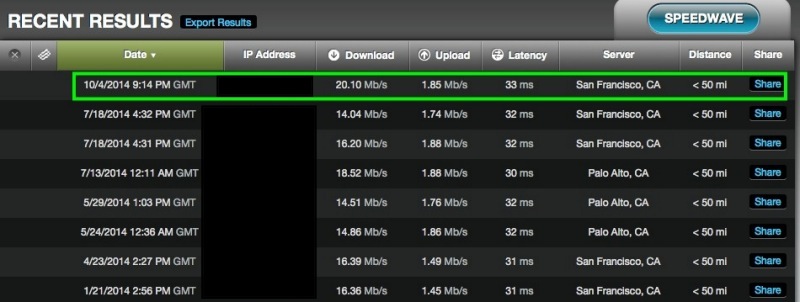
More about Handoff and Continuity when I have OS X Yosemite installed.
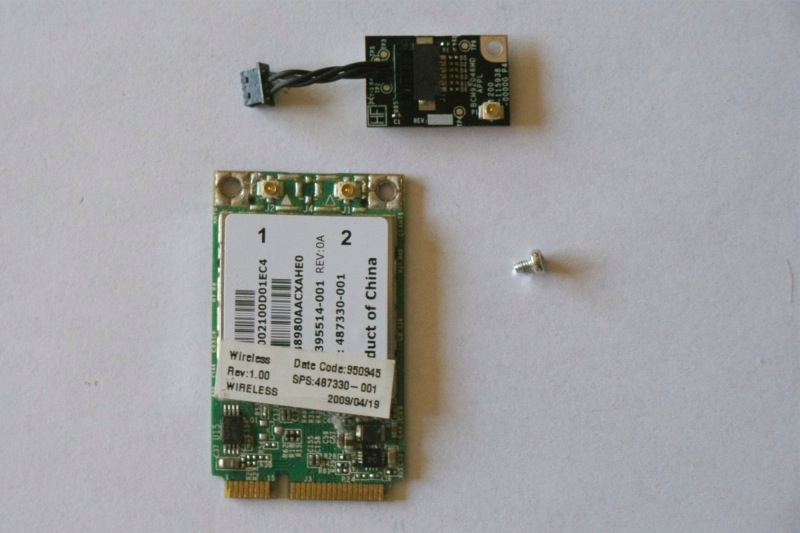
The old Airport and BT cards are discarded.
Anomalies noted:
On my test Mac Pro (2009, dual CPUs, GTX680 GPU) the CPU heat sink fans ran 200-250 rpm faster than usual after installation. However, overnight they settled back to normal after the usual sleep cycle. This machine is seldom turned off.